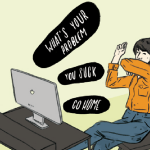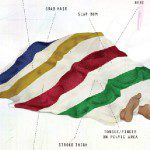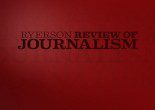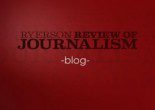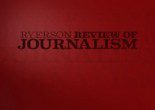Willfully blind
A closer look at the Margaret Wente plagiarism scandal and what it says about The Globe and Mail's institutional arrogance.
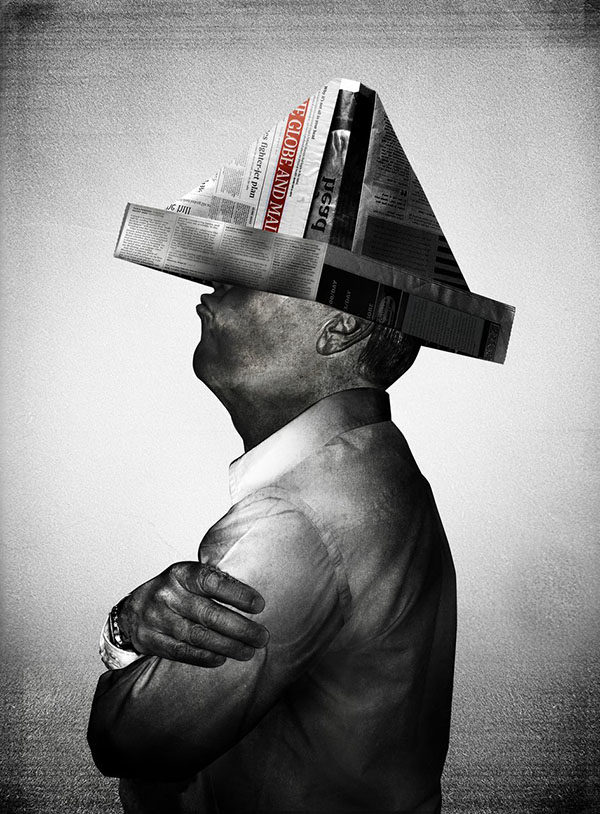 By Brittany Devenyi, Gianluca Inglesi, and Rhiannon Russell
By Brittany Devenyi, Gianluca Inglesi, and Rhiannon Russell
The morning of Monday, September 17, 2012, reader Carol Wainio sent a 2,135-word email to Globe and Mail editor-in-chief John Stackhouse. It detailed multiple instances in a 2009 column by Margaret Wente, “Enviro-romanticism Is Hurting Africa,” of what Wainio called “very significant overlap” with stories from sources as disparate as Food Chemical News and The New York Times. The greatest number of similarities—including virtually a whole paragraph—were with a 2008 article by the Ottawa Citizen’s Dan Gardner. Wainio’s introductory note concluded, “[A]ny comment from you as to whether the examples are consistent with Globe policy would be welcome.”
Stackhouse responded early that afternoon, indicating that he had passed the matter to the paper’s public editor, Sylvia Stead. Wainio wasn’t surprised when she heard nothing more; after all, in May of the previous year Stead had told her, via email, she would no longer reply to her missives.
The next day, Wainio posted her findings on her blog, Media Culpa. In it, she gave side-by-side comparisons of Wente’s prose and that of the other sources. The title read “Margaret Wente: A ‘Zero for Plagiarism’?”
In about 30 previous posts, Wainio had called out Wente for everything from identifying a scientist as a fisherman to relying heavily on a NYT‘s book review without attribution. The biggest result, up to this point, had been corrections or discreet editor’s notes appended to some columns. This time was different. The day Wainio’s blog post went up—Tuesday—National Post columnist Chris Selley took to Twitter: “Sorry, Globe and Mail. But you’re going to have to do something about this.” Maclean’s columnist Colby Cosh retweeted Selley, adding, “Only if they’re capable of shame.” (Wente declined to be interviewed.)
The debacle that rapidly unfolded said a lot about the newspaper that styles itself as the country’s paper of record. It was revealed as arrogant and hubristic, defensive rather than transparent, given to a double standard when confronted with journalistic lapses. As one Globe reporter, who, like others at the paper, chose to remain anonymous for fear of reprisals, says, “The great fear in the newsroom is that the message that has got out there is we just think we’re entitled.”
Over the past four decades, the Globe has had a conflicted and arguably opportunistic relationship with the concept of fostering readers’ trust.
Take the example of the Ontario Press Council, created in 1972 in the wake of the Report of the Special Senate Committee on the Mass Media, or Davey report. As journalist Richard Lunn noted at the time, the document “had some extremely unkind things to say about the ways in which Canadian newspaper publishers discharged their responsibilities to their readers in particular and the public in general.” Yet even the report’s recommendation that the government form a Press Ownership Review Board wasn’t enough to convince the Globe to sign on with the council.
A decade later, the Royal Commission on Newspapers also had stern words about the responsiveness of papers to the public: “It is notorious that the press, which assumes a licence to criticize every other institution, is the least open of any to criticism of its own performance.” The commission proposed an anti-concentration measure that would force the Globe to either sell its other newspapers or fold itself. That got the paper’s attention, as the concerns over opaqueness had not. By the time the Globe joined the OPC, its membership included almost 75 percent of the province’s dailies, with the Globe by far the biggest-circulation outlier.
Given its status as what a former reporter calls “a key part of Canadian society,” the Globe was equally tardy in appointing a public editor. While the Starhas had an ombudsman since 1972 and the NYT appointed its first in 2003, the Globe resisted. Paul Knox, a former long-time Globe editorial staffer who’s now an associate professor at Ryerson’s School of Journalism, believes it was a “pretty deliberate decision not to have one. It wasn’t just by default.”
It’s true—it wasn’t. In 2005, with the support of publisher Phillip Crawley, editor Edward Greenspon formed an Integrity Committee, whose primary brief was to “[p]resent the pros and cons and conduct a survey of other media organizations in North America and Britain that have an ombudsman/public editor.” Today, Greenspon explains in an email, “Given that integrity is a foundational issue, I wanted us to think about how an institution like The Globe and Mail should assure the highest standards in a rapidly evolving environment.” The eight members, who lightheartedly called themselves the Aces, included Stead, then deputy editor; copy editor Kathy English, now the Star’s public editor; and six others.
The Aces presented many recommendations to the senior executives—including Crawley, Greenspon, and executive editor Neil Campbell—from counseling when to run corrections and where to place them in the paper to advising a revamp of the code of conduct. Many were accepted. But in 2006, they advised against the appointment of a public editor, apparently concerned about being a bit too transparent:
“Many media organizations have attempted to deal with these issues [of accuracy and transparency] by appointing an ombudsman or public editor who is independent of the normal editorial hierarchy. As a consequence of these appointments, some media organizations (The New York Times and Washington Post for example) have suffered from public airings of internal editorial disputes.”
Instead, they proposed hiring “a reader/editor who reports to the deputy editor.” Thus arose the role of “reader response editor,” which was given to English. This involved answering reader complaints and drafting corrections. “I did a lot of responses on behalf of the editor-in-chief, on behalf of Edward Greenspon,” English says. “When things would come to him, he’d send them off to me to respond.”
In 2007, when English left to become the Star’s public editor, Gerald Owen, a recent addition to the editorial board, took over. Like English, he reported to Stead, and still does—he continues to perform this role, in addition to his editorial board responsibilities. “[I]t seems as if something comes up of that sort as much as twice a day,” he says.
Finally, Stackhouse created the public editor role in January 2012. “We had discussed this idea for years, and always felt that the editor-in-chief is the public editor. I’m accountable to the public. If readers have a question, I’m always available to them,” he says. “Over time, the deeper I got into the job the more I realized that there needs to be a person within the company beyond the publisher who can challenge the editor and challenge the people that work for the editor.” He appointed Stead. “We opted for someone who knows us, who’s respected internally, and who is going to have both the respect of the readership and the respect of the newsroom.”
Owen congratulated Stead and asked if their working relationship would change. “And she said, no,” he says. “As far as I’m concerned it hasn’t changed at all, because we do confer back and forth quite a bit.”
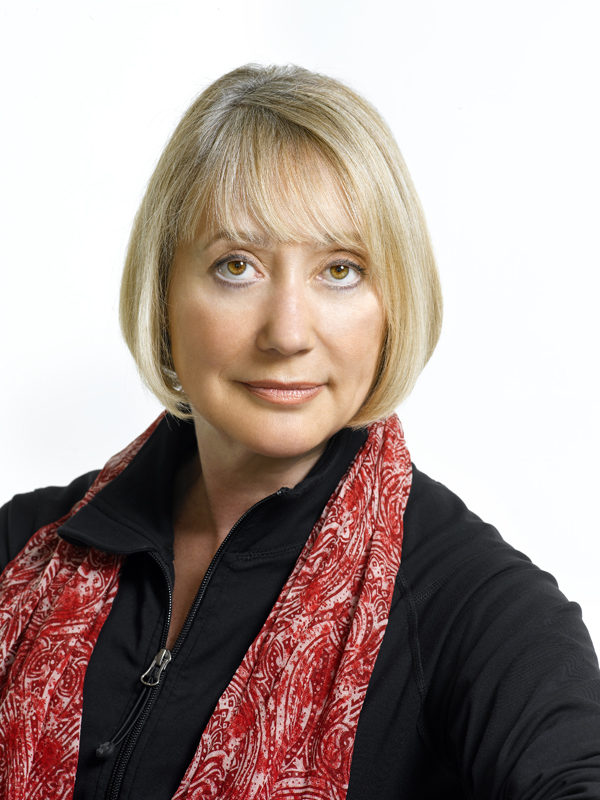 Starting in April 2009, one of the things they doubtless conferred about was the flurry of emails from Wainio regarding Wente’s columns—at least 20 between then and last September. But contrary to Wainio’s impression that she was being blown off—an impression buttressed by Stead’s message that she would no longer respond—Stead and Owen were busy doing damage control. There were talks with Wente about “attributing much more carefully,” and corrections popped up on some of the pieces Wainio had called out.
Starting in April 2009, one of the things they doubtless conferred about was the flurry of emails from Wainio regarding Wente’s columns—at least 20 between then and last September. But contrary to Wainio’s impression that she was being blown off—an impression buttressed by Stead’s message that she would no longer respond—Stead and Owen were busy doing damage control. There were talks with Wente about “attributing much more carefully,” and corrections popped up on some of the pieces Wainio had called out.
As Owen says, “I had been quite involved in a number of corrections and clarifications for Peggy’s work previously [there were at least 10 between 2009 and last September]. And in fact I’d believed we had solved the problem before it came a major public issue.”
They were sandbagged by the scandal arising from the “Enviro-romanticism Is Hurting Africa” column. “The one thing that was really most damaging was one that had occurred before we had started working on this set of problems.”
A typical email from Carol Wainio to the Globe looks much like her blog posts—long, detailed, occasionally nit-picky. “I’m sure it’s annoying to get responses from readers, particularly ones who are persistent,” she says. “But still, there is a bigger issue at stake, it seems to me.”
The artist and adjunct professor in the University of Ottawa’s department of visual arts began her press gadfly career in 2008, when she peppered the Citizen with complaints regarding factual errors in David Warren’s columns and similarities between his prose and others’. Next, Mark Steyn’s tendency to recycle his own pensées in Maclean’s caught her attention. She explains how she decides whom to follow: “When I’ve found a few of these things with a particular author, then I just continue looking at that particular author.”
Wainio first emailed the Globe about Wente in April 2009, regarding a column that contained a quote that had originally appeared elsewhere, and was missing its context. That garnered no response, but a second email in early May to Greenspon about another column’s similarities to material on the Cato Institute website did. Gerald Owen replied, defending Wente and pointing out the distinction between a columnist and a reporter. A quote in a news story, he said, invited an inference that the words had been spoken directly to the reporter, while a columnist’s use of quotes implied no claim to have been spoken to the author. “While I appreciated receiving a response,” Wainio says by email now, “I felt Mr. Owen’s answers didn’t thoroughly address the issue of wandering quotation marks (which sometimes also captured another journalist’s surrounding prose or ideas), the misidentification of speakers, or other issues I had raised.”
A few weeks later, Wainio wrote to point out parallels between a Wente column and a Washington Post piece, and again Owen swatted her away.
Since 2008, Wainio had been passing her findings along to journalist Craig Silverman, best known for his Regret the Error franchise, but his focus was primarily American transgressions, so most of her discoveries didn’t make it to his popular site. After about a year, he suggested she create her own blog. “Basically I said, she seems very good at being able to find the sources to things,” Silverman says of his email to her. So, in January 2010 she created Media Culpa.
Wainio didn’t home in on Wente again until early May 2011, when what she thought was an ill-selected photo accompanying one of Wente’s columns caught her attention. Though the image was undoubtedly not the writer’s choice, Wainio wrote a Media Culpa post about it, and tacked on the end was this startling comparison:
Wente, April 26, 2011: “Red snapper are unbelievable right now,” one fisherman said. “You could put a rock on the end a string and they’d bite it.”
Associated Press, October 2010: “Red snapper are unbelievable right now,” said Mike Carron, head of the Northern Gulf Institute in Mississippi. “Now you could put a rock on the end of string and they’ll bite it.”
Wainio describes Owen’s response: “He just sort of said, Well, I believe Margaret Wente was reading, there was an article about this particular kind of fishing in the leisure section about fly-fishing in The New York Times and she must’ve confused it with that or something.” She makes a skeptical face.
It was Wainio’s next message, about parts of a May column that bore a suspicious resemblance to a 2009 Times article, that prompted the first—and last—response from Stead. Wainio recalls, “I viewed it as sort of threatening. She used words like ‘defamatory.’” Undeterred, Wainio kept shooting bulletins to the paper, and posting on her blog, about things like the phantom Occupy protester who showed up in a November 2011 column—“John,” who was unconnected to the Occupy movement and whose information seemed to come from an Obama campaign site. “They would not respond to me.”
Today, Wainio says thoughtfully, “I think if they had been more forthcoming about fixing those things immediately, I probably would have been less inclined to pursue it as closely as I did.”
Stead joined the Globe in 1975, fresh out of the University of Western Ontario journalism program. Initially a reporter—courts, education, Queen’s Park—she later took on a variety of more senior roles: national editor, executive editor, and, under Edward Greenspon, deputy editor. When Stackhouse replaced Greenspon in 2009, he swept out most of the existing senior editors. “There was great speculation at the time that Sylvia would go, too,” says a Globe reporter. “And in the end, she stayed.” Her new title: associate editor, staff and training.
John Saunders, a reporter who left the paper in 2004, notes, “Every time there was a masthead shake-up, there would be Sylvia, clinging to a piece of the wreckage.” He continues, “She seemed to have a knack for coming out among the living after each purge.” A current staff member suggests the reason for Stead’s longevity: “Sylvia’s hard-working, she’s a good administrator, she does what she’s told. She’s risen very high in the Globe on those credentials.”
“People like Sylvia well enough,” the reporter goes on. “I think some people are very cautious with her because she is a survivor, and so you kind of go, ‘Well, what is it she does to survive?’ She’s played the hatchetman sometimes.”
Take the 2006 incident involving reporter Jan Wong. Following the virulent backlash to her story about the shootings at Dawson College, in which she used the term pure laine to note that three recent school shooters in Quebec were not Québécois, Wong became depressed and took sick leave.
“[Stead] was the one who would drop a letter off at my desk, another disciplinary letter while I was away sick and trying to get back to work,” Wong recalls. Once she had returned to the office, she remembers Stead delivering yet another disciplinary letter. Stead, along with Human Resources, interrogated Wong following the release of Toronto Life’s “Notes on a Scandal,” by David Hayes. They pressed her to admit she had spoken to Hayes, which she hadn’t—she was under a formal gag order.
After she became the Globe’s public editor, Stead moved offices. She had been in a spacious one across from John Stackhouse’s office, in the middle of the second-floor newsroom. Her new space was smaller and off to the side. Post-Wentegate, she moved again. She’s still in the newsroom, but nearer to Crawley’s office. By contrast, at the Star, Kathy English’s office is located in a part of the building occupied by the Star’s editorial board writers and columnists. English says being away from the newsroom, along with reporting to the publisher, allows her to “operate independently of the newsroom and the editor.” Margaret Sullivan, the NYT’s public editor, works in the newsroom, though, as she told Poynter in October, her desk is near the obituary department, which is slightly removed. “It’s a perfect vantage point, because I can easily find the people I need to talk to, but it’s not as if I’m sitting within earshot of reporters and editors,” she said.
Seemingly, no one at the Globe considered the optics of Stead’s office location. Even more telling—and more damaging to the credibility of the position—was the decision to have Stead report directly to the editor-in-chief, with “dotted-line responsibility to the publisher,” as Craig Silverman reported. He interviewed Jeffrey Dvorkin, director of the journalism program at University of Toronto Scarborough and executive director of the Organization of News Ombudsmen. “These days there may be more than one way to be an ombudsman, so as long as the Globe has guaranteed Sylvia’s independence to investigate and report, it may be possible to have a different model,” Dvorkin said. “But the credibility of the position with the public and the newsroom is based on the ombud’s freedom to operate and not be perceived as management with a different title.”
The unconventional reporting arrangement, which one observer bluntly calls “effed,” may have further hampered Stead. “When all this Wente stuff blew up, she of course didn’t have much latitude,” says a former staffer. “There was not much she could do because she was answering to an editor who had already decided to support Wente. Now she’s answering to the publisher, so it’s possible she’ll have more time to do a better job as public editor.”
Still, there’s the fact that during Stead’s 37 years at the paper, she’s played a role in personnel matters and supervised many reporters and editors, directly or indirectly. That history makes her an unlikely fit for the job, says Paul Knox, the former Globe staffer now at Ryerson’s journalism school. “She’s one of the longest-serving employees there, a person who had occupied senior management positions for a long time,” he says. “So existing practices, one could argue, are very much things that had her fingerprints on them.”
While he praises Stead for “her ability to mediate and smooth troubled waters,” he also wonders, “Do you want the public editor to be a mediator? Or do you want the public editor to be a person who is the readers’ advocate, and who is able to distance themselves from the way things look in the editorial department and say, What does it look like from outside?” He answers his own question: “I think it would be hard for anybody who had been there as long as Sylvia, had been in as many senior management positions, to see the world as an independent reader sees it.”
During the time Stead has been at the Globe, there have been three high-profile plagiarism cases. In early September 1980, Dick Beddoes, an acclaimed columnist, cribbed extensively from the NYT’s Russell Baker. Within two weeks, Beddoes was gone, after a graceful and contrite mea culpa: “This is a correction, an apology, a confession of error, a disorderly retreat.”
A decade later, an arguably much more subtle and controversial plagiarism case occurred. In November 1990, Deirdre Kelly’s editor accused her of parroting another writer’s sentence in a story. Suspended briefly without pay, she was warned that future plagiarism would warrant immediate termination. Three months later, a security guard escorted Kelly to her desk and told her to pack up her belongings. The issue this time was a phrase in a piece on figure skating that had appeared in an earlier Maclean’s piece.
Unlike Beddoes, Kelly refused to accept her Globe expulsion. “I knew I had done nothing wrong. I had to fight back. I launched a grievance, backed by the newspaper’s union,” she wrote in her book Paris Times Eight. In August 1994, an arbitration board ruled she should be reinstated with back pay, finding that she “acted in accordance with the standards of journalism accepted in the newspaper industry.”
The current standard at the Globe is clearly outlined in its code of conduct: “Excerpts from other people’s prose must be attributed so as to avoid even a suspicion of copying. Although it is sometimes reasonable to adopt a few words without attribution (in a technical definition, for example), careful judgment is required….Any extensive unacknowledged use of another’s words, structure or ideas may constitute plagiarism.”
In the prelude to the Wente case, it was no secret in the newsroom that there had been complaints about her work. “Certainly people within the newsroom were aware of the [Media Culpa] blog, and they were aware that these accusations were made,” says a source. “And had been made for some time.” Staff whispered in the corridors, the source adds. “But nobody was going to actually go to a manager and say, ‘What the hell?’”
It took a long three days for Stead to address the “Zero for Plagiarism?” blow-up. When Stackhouse appointed her public editor, he had promised a figure whose role was “to make the organization more transparent and accountable to its readers and the general public.” Instead, the headline on Stead’s blog—“We Investigate All Complaints Against Our Writers”—suggested a Globe loyalist on the defensive. Ditto for the skepticism reflected in her statement: “The concern was that seven different sources were reproduced. That seems highly unlikely.” Then there were Stead’s references to Wainio as an “anonymous blogger.” As English wrote at the time, “Given that Stead had a history of corresponding with Wainio about Wente’s work, this was not the full story—the aspect of all of this I find most unsettling.” (Later, Stead wrote, “I should have referred to the blogger’s complaints, not the anonymous blogger. In the meantime, I have asked Carol Wainio if she wants me to refer to her by name and she said yes, so I will.”)
The brush-off didn’t work. One Globe source characterizes management’s initial reaction as “arrogance,” and then “panic as they realized, Oh, my God, we can’t just do our usual Globe thing and be really snotty and disengaged. We actually have to be responsive.” Stackhouse himself says he was unaware of the fiasco until September 21, “but I didn’t get to look into it deeply until the Saturday. And I felt upon investigation this was something that deserved a greater degree of attention, and it went from there.”
The following Monday, he released a statement: “The journalism in this instance did not meet the standards of The Globe and Mail in terms of sourcing, use of quotation marks and reasonable credit for the work of others. Even in the spirit of column writing, which allows for some latitude in attribution and expression, this work was not in accordance with our code of conduct and is unacceptable.” The statement indicated Stackhouse had “taken appropriate action” on the disciplinary front, although not what that was, and mystifyingly contained his pledge to “continue to defend [Wente’s] right to free expression.” Finally, he announced that “the Public Editor position should be made fully autonomous from the newsroom,” and that Stead would now report to the publisher.
The next day, the paper carried a column by a not-particularly-chastened-sounding Wente: “I’m far from perfect. I make mistakes. But I’m not a serial plagiarist. What I often am is a target for people who don’t like what I write.” Then she disappeared from the paper.
Meanwhile, Stackhouse was engaged in an uncharacteristic activity. “There was an unprecedented series of meetings that John Stackhouse had department by department,” a source says, “and in those meetings, he mainly just listened to what staff had to say.” He is upbeat about the exercise: “There was a good airing of concerns, and I heard a great many insights in terms of the process—how we edit, how we assign, how we question and challenge writers. That was healthy and helpful.” The source, however, says two themes emerged. The first was that the staff didn’t think the Wente furor was going to fade.
The source continues, “And the second message, perhaps more quietly or more subtly, was the sense that there was a double standard, that there was one rule for a famous columnist and another for the rest of us. In the years I’ve been there, I have seen many instances where there’s one treatment for someone who’s not in favour and another kind of treatment for someone who is in favour.” For example, the paper did not stand by Wong. It did stand by Wente. “So, yeah, there are favourites. And that’s another thing that obviously is very, very detrimental to the morale of the newsroom.”
In just over two weeks, Wente was back in her usual space on the op-ed page.
“Many editorial staffers were under the impression that plagiarism is a firing offence,” says an insider caustically. “We now know that that is not true.”
Six days after the RRJ submitted questions to Stead by email—she could not be contacted by phone—she’s responded. She ignores the query about the Wente affair (“What did you take away from the Globe’s interactions with reader Carol Wainio?”). In answer to the question about the importance of the public editor role, she serves up a quote from the Stackhouse announcement of her appointment. Overall, there’s the sense her answers have been carefully vetted and buffed:
“The [public editor’s] job is to represent readers’ interests and I think it can be better done by someone who has managed serious news files and is respected for their journalism.”
And, “As someone who has worked for the Globe for many years and been a reader even longer, I also care very deeply about the quality and integrity of the newspaper and website and want it to be its best.”
Her response is just over 400 words long.
More than Crawley’s. In reply to an interview request, he emails that Stead will respond, adding, “If the Ryerson Review publishes a piece about the Globe that is balanced and fair, that will be a first.”
A second contact with Stead regarding the various allegations about her gets a speedier response. She’s not any more forthcoming, though: “I have answered your previous fact-based questions as you know, but I will not respond to anonymous opinions.” She adds pointedly, “The Globe and Mail’s policy on the use of anonymous quotes might be instructive: ‘Reporters should strive to minimize the use of unattributed quotes, keeping in mind that the justification for omitting attribution is to get the fullest story possible, not to let people dodge accountability or take anonymous potshots.’”
Stackhouse, by comparison, is almost disarmingly cooperative. (A former staff member at the paper says this is his characteristic response to awkward situations.) In a phone interview, he answers questions about the choice of Stead, the unconventional original reporting structure, and the importance of transparency vis-à-vis readers, saying about the last, “We’re in an age of authenticity, and that means the credibility of everything and everyone is being put to a new level of scrutiny, and the media is no exception. The transparency, and being open to readers, is an essential part of any credible media operation.” Nothing new there.
What is startling is his disclosure that he wasn’t aware Stead had stopped replying to Wainio in May 2011: “I don’t recall knowing Sylvia was not responding to her. I know I learned that later, after all of this blew up, but at the time, I think I was still referring Wainio’s emails to Sylvia.”
And then there is this exchange, after a long response to the question of whether plagiarism—“a word that is often misinterpreted”—is a firing offence at the Globe:
“So you’d say that what Wente did isn’t plagiarism then?”
“I’m not going to comment on that.”
by Brittany Devenyi, Gianluca Inglesi, and Rhiannon Russell
Brittany was the Chief Copy Editors for the Summer 2013 issue of the Ryerson Review of Journalism.




